 |
Kelly Johnson and the U-2 |
Kelly's Angels
The Lockheed UFO Case
[This article originally appeared in International UFO Reporter]
Lockheed: Star Company
Those
who have relived the Cuban Missile Crisis through films like Thirteen
Days and books like Dino Brugioni's Eyeball to Eyeball, or
who have experienced the tension of the shootdown of a US spyplane over
the USSR in Michael Beschloss's Mayday, are familiar with the vital
role that the Central Intelligence Agency-sponsored U-2 played during
the Cold War. The remarkable, high-flying covert strategic reconnaissance
aircraft provided the means by which US intelligence analysts were finally
able to pinpoint and quantify the Soviet strategic threat to the West.
By dispelling an early myth of Soviet nuclear superiority known as the
Bomber Gap, it helped reduce pressures to escalate the arms race, and
to this day it continues to span the globe on vital intelligence-gathering
missions, treaty verification overflights, and environmental sensing tasks.
The U-2 has a unique place in UFO history as well. It was first test flown at Groom Lake, a secret airbase inside the restricted zone surrounding the Atomic Energy Commission's Nevada nuclear test range. Groom Lake, also known as "The Ranch," "Watertown Strip" or most popularly as "Area 51," has become inextricably intertwined with fantastic rumors of "captured UFOs," "reverse-engineered alien technology" and endless other exotic ideas. While not commenting on such matters, the CIA has officially stated that the U-2 and its successor, the 2,400 mph A-12 OXCART, were themselves responsible for UFO reports in the 1950s and 60s.
 |
Given its stellar aerospace achievements, it's fitting that Lockheed's company logo has always been a winged star, and its aircraft and missiles were traditionally named after stars or celestial phenomena: Orion, Vega, Polaris, Constellation, Starfire, Starfighter |
It's somehow fitting, too, that in December 1953, at the very moment of the U-2's birth, a group of Lockheed's top engineers and pilots made what is potentially one of the more scientifically significant UFO sightings ever recorded. As intriguing as the UFO incident is, it has languished in the Project Blue Book files for nearly half a century, stamped "Identified," buried, and nearly forgotten. Recent study of the Blue Book case file yielded the names of seven eyewitnesses - a crew of Lockheed flight test engineers in the air, and Lockheed's Chief Engineer and his wife on the ground. The Chief Engineer was Clarence L ("Kelly") Johnson - the creator of the U-2. [1]
Kelly Johnson
Johnson was undisputedly one of the greatest aeronautical engineers of all time. In his 42-year career with Lockheed he participated in or oversaw the development of many of the company's most famous airplanes. Born into the large family of a poor immigrant laborer in Michigan, Johnson was a study in contrasts: scrappy and hardworking, studious and awed by airplanes, he built houses to help support his family while still excelling in school. Determined to become an engineer, Johnson was fortunate to be accepted by the outstanding aeronautical engineering department at the University of Michigan, where he eventually became the assistant of Professor Edward Stalker, an expert in aerodynamics.
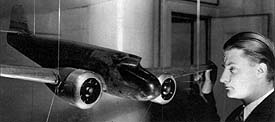 |
Johnson with early Electra wind tunnel model at University of Michigan |
Johnson joined Lockheed in 1933 as an aerodynamicist and assistant to chief engineer Hall Hibbard. By 1938 Hibbard and his young partner had developed the P-38 Lightning fighter, the world's first 400 MPH combat aircraft.
 |
Johnson and Amelia Earhart discuss her Model 10E Electra |
 |
YP-38 prototype, 1941 |
And by the time the P-38 was entering service, the two designers were looking far into the future, having launched a secret study of a highly sophisticated, radical-looking 625 mph fighter powered by a completely new form of engine called the turbojet, as developed the company's own visionary propulsion expert, Nathan Price.
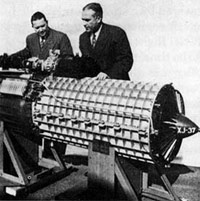 |
Hall Hibbard (left) and Nathan Price with Price's XJ-37 turbojet engine. Price had been hired to redesign the turbosuperchargers of the P-38 and brought his jet engine concepts to Lockheed in 1938. Hibbard and Johnson began incorporating them into a radical jet fighter project, the Model L-133, in 1940 |
 |
The 625 mph L-133 was a quantum jump beyond the already advanced P-38. Bursting with highly innovative features (canard surfaces to combat control problems near the speed of sound, thin wings for maximum critical Mach number, laminar flow control using boundary layer suction for drag reduction, turbine intercooling using surface radiators, and reaction thrusters for roll control), it was simply too much for the Army Air Force to absorb at the time |
The
conservative Army Air Force was not ready for near-sonic speed jet fighters
in 1941, but three years later, confronted with Nazi Germany's advanced
aircraft, it turned to Hibbard and Johnson with an urgent request to build
a no-frills operational jet fighter around a less technically advanced,
but more developed, British jet engine. Under the most stringent security
measures, Johnson undertook one of the first "black" airplane
projects, hand-picking a cadre of his best engineers and setting up a
special division of the Burbank, California-based company, soon dubbed
the "Skunk Works," to design and build the new fighter, the
XP-80 Shooting Star, within a matter of months. The airplane was a huge
success, and Johnson and his Skunk Works engineers were on their way to
becoming legends.
Kelly
Johnson was pugnacious, stubborn, serious and combative. Yet he had an
almost artistic flair for matters aeronautical. One of his bosses remarked
that Johnson could "see air." His successor, Ben Rich, commented
on Johnson's more earthy side this way:
All of us had seen him rushing around in his untucked shirt, a paunchy, middle-aged guy with a comical duck's waddle, slicked-down hair, and a belligerent jaw. He had a thick, round nose and reminded me a lot of W. C. Fields, but without the humor. Definitely without that. Johnson was all business and had the reputation of an ogre who ate young, tender engineers for between-meal snacks. We peons viewed him with the knee-knocking dread and awe of the almighty best described in the Old Testament.
By the end of his eventful career, Johnson had won every major aeronautical award, some more than once, and had received special citations and medals from scientific organizations, the CIA, and President Ronald Reagan.
Lockheed and UFOs
Partly
because of their ubiquity and partly because of their superior performance,
Lockheed aircraft have played roles in many of the pivotal cases in UFO
history. Its fighters chased radar UFOs over Washington, DC in the summer
of 1952, and other Lockheed military planes were involved (or implicated)
in significant events like the Great Falls UFO film case in 1950, the
Ft Monmouth UFO chase of September 1951, the fatal Walesville incident
of 1954, and a host of other UFO intercept events. Capt Edward Ruppelt
reports in his memoirs of Project Blue Book that in 1952, an Air Defense
Command Colonel, harassed by continuing UFO sightings near his New Mexico
base, proposed converting several of Lockheed's latest F-94C fighters
into actual dedicated "UFO interceptors." Equipped with a battery
of nose-mounted cameras and standing 24-hour alert in an operation called
"Project POUNCE," the fighters would be used in an attempt to
obtain clear, closeup photos of a saucer in flight.
 |
Lockheed F-94C Starfire - the first USAF radar-equipped bomber interceptor with air-to-air rocket armament and near-sonic performance. Entering service in 1952 in limited numbers, the F-94C was the USAF's top interceptor at the time of the Lockheed UFO incident |
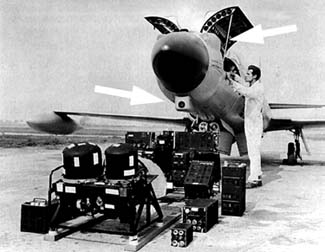 |
Hughes Aircraft built the radar system used in the F-94C. This Hughes-operated Starfire testbed shows a triple camera pod installation (arrows) mounted in the fighter's nose rocket compartment. This probably resembles the intended camera package of the Project POUNCE UFO interceptors proposed by Col Methany at Kirtland AFB in 1952 |
Lockheed's
official public pronouncements on UFOs had been negative. For example,
on July 7, 1947, Hall Hibbard had made disparaging remarks to Los Angeles
Times reporters who inquired about the saucers being reported nationwide:
They're either reflections from planes flying singly or in formation, or mass hysteria and the desire of various persons to get their names in the paper. I know of no secret aviation projects which would have the slightest bearing on these so-called 'phenomena.’
Nevertheless, the company harbored at least two prominent engineers who were interested in UFOs - as well as two notorious UFO "contactees."
Beginning in January 1952, former Lockheed aircraft mechanic George Van Tassel experienced a series of mental communications with a retinue of extraterrestrials who, he said, were based in a spacecraft hovering 80,000 feet over Giant Rock, a remote desert airfield near Yucca Valley, California. Van Tassel produced a book later that year, and by early 1954 he was hosting public ET "channeling sessions" which evolved into the famous annual Giant Rock saucer conventions. In August 1953, one of the extraterrestrials finally landed and gave Van Tassel a tour of his saucer.
 |
|
Orfeo
Angelucci, a laborer who built fiberglass nose radar domes for the F-94,
was another Lockheed employee who claimed contact with UFO occupants.
One evening during May 1953, as he told it later, Angelucci was driving
home from Burbank when he experienced an encounter with a red, oval object.
The UFO deployed a screen-like construct that displayed images of majestic
humanoid beings. A few weeks later he entered a landed UFO which took
him a thousand miles into space, where he was shown a thousand-foot "mothership"
and given a tutorial on the intentions of the aliens by a disembodied
voice. In September, Angelucci went on a week-long "psychic journey"
to the home world of the humanoid beings. The alien leader's name was
Orion, and he told Angelucci that his own true name was Neptune - both
being names, oddly, of Lockheed airplanes. Angelucci's religiously-tinged
story was so distinctive that legendary psychologist Carl Jung devoted
considerable attention to it in his 1959 book "Flying Saucers: A
Modern Myth Of Things Seen In The Skies."
Around
the time Van Tassel and Angelucci were reporting their tales of encounters
with astronauts from other worlds, Lockheed propulsion expert Nathan Price
began to devote a considerable amount of effort to the creation of two
fascinating concepts for disc-shaped aircraft of extreme performance.
Price's place in the history of turbojet engine development in the US
is seldom highlighted, but given that he was working on an extremely sophisticated
jet powerplant as early as 1938, his visionary disc aircraft designs are
noteworthy.
Filed in early 1953 (and not granted until a decade later), the patents depict a 50-foot diameter, 55,000 pound lens-shaped flying wing which incorporated a huge central turbo-ramjet of unique design. Much like today's Lockheed Martin X-35 Joint Strike Fighter, the 1952-3 Lockheed saucer was to be able to take off vertically by vectoring its central engine's thrust downward. Once airborne, the engine's nozzles would rotate to an aft-facing position and the saucer would accelerate in a shallow climb to 50,000 feet, where it would reach supersonic speeds, its engine gradually transitioning from turbojet to ramjet mode. When it leveled off at 100,000 feet, the vehicle would be cruising at four times the speed of sound - approximately 2,700 mph.
 |
This version of Price's Mach 4 saucer appears to be a personnel transport equipped with a set of aft-facing seats |
As
advanced as these ideas were, anticipating in some respects the engine
systems of the famous "Blackbirds" that flew ten years later,
perhaps the most striking aspect of Price's saucer is that it was intended
to use propane, butane or liquid hydrogen fuels, and the patents cover
some of the sophisticated engineering details and special tank technologies
that cryogenic fuels require. Standard histories of Lockheed's work on
hydrogen-powered aircraft indicate that the Skunk Works only attempted
to actually build such components under the highly-classified Air Force-sponsored
SUNTAN reconnaissance aircraft project circa 1956-7. Engine designer Price
was thinking years ahead with his saucer, and given the amount of airframe
detail that the patents show, it's tempting to speculate that the designs,
like the L-133 of a decade before, were the result of more than his work
alone.
While Kelly Johnson and other Lockheed engineers have long been rumored to have been interested in UFOs, the Blue Book sighting file, as will be seen, provides definitive proof.
Birth of the U-2
Johnson ended his career crowned with glory, but in late 1953, the forty-three year old engineer was in the thick of the fray, entering what would turn out to be the most productive decade of his career. Having succeeded Hibbard as Chief Engineer the previous year, Johnson was facing greater challenges than ever before and was managing several complex aircraft programs, not all of which were going smoothly. As the end of the year approached, he was anticipating the completion and rollout of his controversial new XF-104A Starfighter, the prototype of the world's first Mach 2 combat aircraft. Johnson's reputation within some Air Force circles had reached such a level that when he had proposed the fighter - unsolicited - to General Donald Putt's Air Research and Development Command (ARDC) in Baltimore the previous year, one of Putt's Colonels, Bruce Holloway, had promptly written a specification around the design and placed an order for prototypes. But not everyone in Air Force R&D was so enamored of Johnson or Lockheed. Political factors always influence development decisions and contract awards, and the Skunk Works was not necessarily always the contractor of choice at Wright-Patterson Air Force Base.
 |
XF-104 |
As the F-104 was being prepared to be shipped to Edwards AFB for its maiden flight, Johnson heard rumors of Air Force and CIA interest in developing a unique new type of covert strategic reconnaissance aircraft, highly specialized and intended to fly at heights that would insure that no enemy defenses would be capable of reaching it - or even detecting it at all, if possible.
The
Wright Air Development Center engineers who were writing the specification
for the new airplane had not approached Lockheed for a proposal for this
requirement, planning instead to work with smaller, more easily managed
airframe contractors. Based on the CIA's own history of the U-2's development,
and on chronologies by experts Jay Miller and Chris Pocock, it seems likely
that the unofficial source of the information about the reconnaissance
requirement was Johnson's personal friend Philip Strong, a Reserve US
Marine Corps Colonel who was Chief of the Operations Staff of CIA's Office
of Scientific Intelligence. In addition to his concerns over building
a CIA role in technical intelligence gathering, Strong had a keen interest
in UFOs, having been an organizer and attendee at the CIA's
Robertson Panel meetings in January 1953. [2]
 |
CIA |
Johnson considered that the fast-climbing XF-104A's minimalistic airframe would be an ideal basis for addressing the new special strategic reconnaissance mission - if it were modified with giant, glider-like wings and lightened by elimination of such items as landing gear and ejection seat. The new airplane, given the Lockheed model number CL-282, began gestating in Johnson's mind at the very end of 1953. His journal for the project, "Log for Project X," has a first entry date of December 1953.
 |
CL-282 |
See: Building the Unknown: Design Studies for a Covert Reconnaissance Aircraft
The UFO Incident
On December 16, Johnson and his wife Althea were visiting their Lindero
Ranch near Agoura, California, which was situated on a hillside facing
the coast not far from Pt Mugu Naval Air Station, an aircraft and missile
test facility. At about 5 PM Johnson was looking through a window at the
brilliant sunset when he noticed a dark elliptical shape in the sky in
the direction of Pt Mugu cape. His first thought was that it was a lenticular
cloud, or possibly a smoke trail from an aircraft, but it remained stationary
and unchanged for several minutes. He called for Althea to bring him his
8-power binoculars and ran outside. By that time the object had begun
to move, accelerating away from him in a shallow climb in a direction
opposite to the motion of the other clouds in the sky. It seemed to be
very large and distant, and moving fast, but he had no real way of knowing
its actual size, distance or speed.
At the same time, coincidentally, a Lockheed airplane was in the air on a test flight along the Los Angeles coastline. Constellation airframe 4301 was the prototype for a Navy Airborne Early Warning (AEW) aircraft, the WV-2 Warning Star. The WV-2 was a large four-engine transport equipped with huge blisters housing radar antennas (a search radar unit in the belly and a height-finder in a dorsal fairing), and was designed to fly very long standing patrols far off the coasts of North America to provide long-range detection of incoming Soviet bombers. Constellation 4301 was the first of a long line of Navy WV-2s and Air Force EC-121s that would provide a vital part of the North American air defense network throughout the 1950s and '60s.
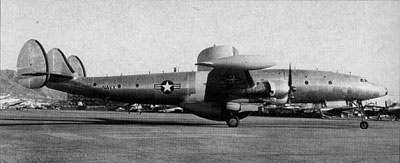 |
WV-2 airframe number 4301, USN serial number 126521, the aircraft involved in the UFO incident |
See: WV-2 and EC-121
See: Navy Air Defense
At the controls of the Warning Star were Rudy Thoren and Roy Wimmer, both highly experienced senior test pilots in the Constellation program, assisted by Joseph F. Ware, Jr, another longtime Lockheed engineering test pilot.[3] Also in the cockpit were Charlie Grugan, another veteran company pilot, and Lockheed's Chief Aerodynamicist, Philip A Colman. It was customary for Lockheed engineers to ride aboard their planes during test flights, and Johnson himself often did so. (There are no indications that the elaborate radar systems, which required a crew of at least a dozen men, were active during the flight.)
 |
|
Philip
Colman, Roy Wimmer, and a Lockheed flight test crew including Johnson
and Wimmer (second from right and right)
|
Thoren had been recruited by Johnson from their alma mater, the aeronautical engineering school at University of Michigan, and had been Chief of Flight Test for Lockheed since 1946, in charge of all the company's test pilots. Colman was a Cal Tech graduate who had made valuable contributions to the P-38 program, and who would soon be tasked by Johnson with designing the wings for the new CL-282 recon plane. All of the crewmen were top representatives of their fields, having flown for the company for years in development programs of a variety of sophisticated aircraft.
The
exact purpose of the test flight is not detailed in the sighting reports,
but such flights typically involved calibration of airspeed vs engine
power settings at various altitudes, and therefore the crewmen were very
conscious of the height of the aircraft. Altitude recording instruments
were carried on board.
Though
Wimmer was technically the pilot in command, he had turned the controls
over to Thoren and was maintaining a watch for other air traffic as Thoren
conducted his tests. They had turned from a southeast heading to west,
just off the coast of Long Beach, when, at 4:58 PM, Wimmer noticed a dark
shape ahead at about their altitude of 14,000 feet. After watching it
for a few moments and noting that it was not moving, he jokingly pointed
it out to Thoren, saying "Look out, there's a flying saucer."
Thoren turned the WV-2 a bit to the right to head toward the object. The
other men saw the object too and watched it for a few minutes with a growing
sense of curiosity. It appeared to be a very large aircraft of some type,
but as it remained stationary and unchanged in shape over at least a five
minute period, they became more and more intrigued. Thoren finally diverted
from his course and headed directly at it. They flew toward it at about
225 mph for some time without appearing to gain on it at all. Then Wimmer,
who was less occupied with piloting tasks and was able to keep a constant
watch on the object, commented that it seemed to be disappearing. Within
a few moments it appeared to head west directly away from them at high
speed, remaining dark and solid-looking the entire time as it dwindled
to a tiny dot. They all felt that it was a large object at a considerable
distance, and compared its size to the largest types of transport or bomber
aircraft. The men later reported that they thought little more of the
incident at the time due to their preoccupation with completing the test
mission, but Thoren was intrigued enough that upon returning home that
evening he told his family about the sighting and sketched the object.
The following day, Kelly Johnson had returned to work and was discussing the WV-2 test flight with Thoren, who was still ruminating on the incident. A bit worried that Johnson would ridicule him, the pilot casually mentioned the sighting. Thoren was surprised when Johnson excitedly interrupted him and described his own sighting in detail. Both concluded that all the witnesses had been viewing the same object at the same time. Over the course of the next few weeks each of the pilots wrote a detailed personal account of the case, probably at Johnson's urging, and the Chief Engineer, in his typical meticulous style, assembled them into a file (Lockheed file LAC/149536) and drafted a personal cover letter addressed to the "Air Force Investigation Group on Flying Saucers" at Wright Field. Then, tough and combative as he was, Johnson hesitated to send the report. After all, he was hoping to get a foot in the door of the Air Force's new covert strategic reconnaissance aircraft competition and was very concerned that a UFO report might jeopardize his credibility. He may have sought the advice of his friend, Lt General Donald Putt.
See: Project Blue Book Case File for the Lockheed incident (12 pages)
See: Unsanitized Version of Case File (15 pages)
General Putt's Involvement
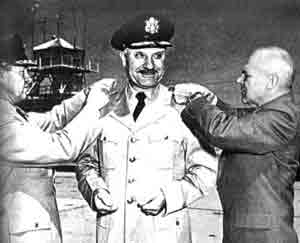 |
Putt receives his second star from generals Craigie and Doolittle |
ARDC
commander Putt, who had the responsibility for reviewing and approving
new Air Force reconnaissance projects like Johnson's CL-282, had also
had a long, if intermittent, association with the UFO problem. A former
test pilot with a solid Cal Tech engineering background, Putt was one
of the stars of the Air Force, having risen to prominence as project officer
for the B-29 bomber during WWII. Closely allied with Theodore von Karman's
Scientific Advisory Board (he would be its military supervisor for several
years), Putt had helped make science and advanced technology the backbone
of the emerging air service. He had been commander of T-2 Air Intelligence
during a crucial period following the end of hostilities in Europe and
had been a strong backer of Operation Paperclip, the transfer of German
aeronautical scientists to Wright Field. A widely-respected, politically
savvy officer, Putt showed little evidence of the antipathy to UFOs that
many other Air Force generals exhibited. In December 1948 Project RAND
missile expert James Lipp had written a paper at Putt's request that examined
the possibility that UFOs were extraterrestrial spacecraft that used propulsion
principles comparable to known or foreseeable rocket technology. (The
fascinating paper was published as an appendix to the final report of
Project SIGN.)
Just months before the Lockheed UFO incident, Putt and twenty-five USAF scientists and officials had visited the plant of Avro Aircraft Limited in Toronto, Canada, where he had seen a full-scale engineering mockup of an advanced, supersonic saucer-like aircraft, "Project Y," that had been conceived by a group of ex-British engineers.
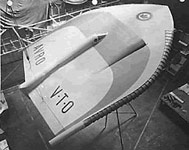 |
Avro Project Y mockup courtesy Bill Zuk |
He
was impressed enough by the design that ARDC would begin to fund its development
within the year. The Project Y vehicle was a virtual replica of Kenneth
Arnold's initial June 1947 sketches of a "spade-shaped" UFO,
probably because the Avro craft's chief designer was an avid collector
of UFO data and considered Arnold's report to be reliable. The Project
Y machine, which had been under development since the fall of 1951, was
somewhat similar to Nathan Price's 1952-3 concept, and like the Lockheed
saucer was intended to be able to take off vertically, hover in midair,
and climb to extreme altitudes at incredible speeds. It seems likely that
Lockheed, having originated one of the most sophisticated saucer-like
aircraft concepts to date, would have been aware of the the Avro design
prior to the UFO incident.
See: Project Ladybird
In any case, Putt's visit to Avro was no secret. It was featured prominently in US newspapers, particularly in the New York Times. In two articles, one in September, at the time of the trip, and another in early October, the Times discussed Putt's interest in the Avro VTOL disc. Perhaps a more important indicator of the effect of Putt's Avro visit was Project Blue Book's Report 12, which was issued about eleven weeks before the Lockheed UFO incident. Report 12 devoted several pages to a somewhat garbled history of the Avro project and its designer's attempts to interest the US in the concept. The report noted that the Avro engineers believed that the Soviets were responsible for many UFO reports, and that Red saucers were being launched from submarines off the North American coasts on surreptitious overflights of the US. Avro, Report 12 said, wanted to install their saucer in submarines too.
Oddly enough, an article touting Putt's positive comments about the Avro saucer appeared in the December 16 edition of the magazine "People Today" -- the very day of the Lockheed sighting.
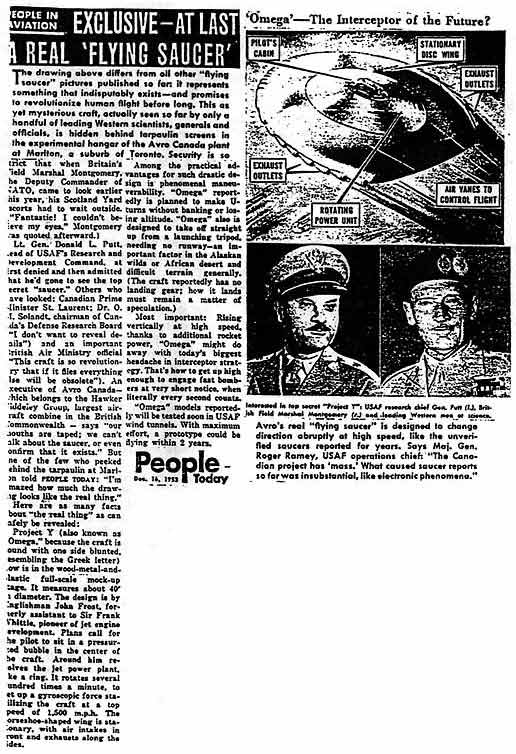 |
Putt clearly made his views on the Avro saucer known within the Air Force as well. On December 29, Maj Gen John Samford, Air Force Director of Intelligence, memoed Col George L Wertenbaker, ATIC chief, on the Avro program.
It is my understanding that you are continuing an active interest in the 'Flying Saucer' being developed by the Canadians. Also, you may have knowledge of General Putt's reaction to their program from his recent trip to that country. I would appreciate your analysis of this Canadian program. There is also an interest from both the possibility standpoint, and the time factor required by a foreign country to achieve results in this field. If you so desire, we might be able through our contacts with the Canadians here, to arrange ATIC representation during this development, or phases thereof.
Kelly
Johnson had close personal and professional ties with Putt and officers
like him, and it's likely that some time in early 1954 the two discussed
the UFO sighting. Putt also received a copy of the formal Lockheed sighting
report from the company via some unnamed intermediary. The general understood
Johnson's concerns about the credibility problems a UFO report would cause,
and forwarded the file to Col George Wertenbaker at the Air Technical
Intelligence Center at Wright-Patterson AFB in mid-February with personal
cover letter.
"This report was handed to me by Lockheed personnel," Putt informed Wertenbaker,
with the explanation that Mr. Johnson was most reluctant to write the report in the first place and then refused to forward it on to you because of his belief that those who profess to have seen flying saucers are not usually considered to be logical and practical hard-headed engineers. However, I thought you should have the report for whatever value it may be in your overall studies.
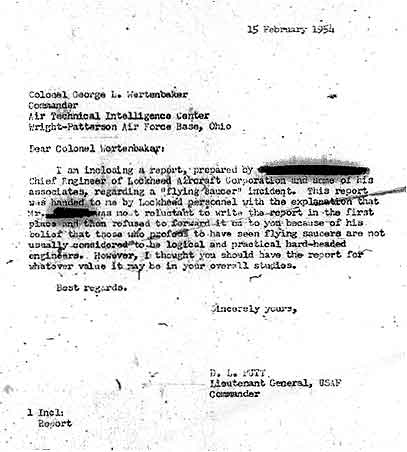 |
One would think that Putt's intervention would have guaranteed that the incident would be taken seriously by ATIC. Nevertheless, the eventual official Blue Book evaluation was that the object was just a lenticular cloud.
The Case File and Its Implications
Although
the sighting was not highly dramatic in comparison to many UFO reports,
what makes it particularly unusual - and scientifically useful - is that
it was a long-duration daylight sighting of an object seen by two independent
groups of observers. Moreover, these groups - one stationary and one moving
- were separated by very long baselines in both horizontal and vertical
planes, facilitating triangulation of the object's position. One group
even had the advantage of using optical instruments to view the UFO. Unlike
many sensationalized UFO events, these observations were recorded in a
calm, professional manner by the witnesses themselves while the details
were still fresh in their minds. No media attention was sought or desired.
And most importantly, the integrity and competence of this particular
group of observers is almost unquestionable. A more qualified set of eyewitnesses
would be hard to imagine.
Because
of their precise observations and careful documentation of the incident,
a great deal of information can be extracted from the account. Available
weather data makes it clear that Blue Book's rubber-stamp identification
of the object as a lenticular cloud is untenable...and therefore the object's
identity is still a mystery.
There
was no question in about this in Kelly Johnson’s view. He was absolutely
certain that it was no cloud, aircraft or other mundane object.
The
case file reveals a multitude of intriguing threads, including references
to prior sightings by several of the engineers. Johnson furnished two
signed sketches with his report. One showed the December 1953 object,
a simple flattened ellipse, but the second, dated "about November
1951," shows a strange object resembling a rounded, sweptback flying
wing aircraft. In his written account, Johnson elaborates:
I should also state that about two years ago Mrs. Johnson and I saw an object which I believed at the time, and still do, to be a saucer, flying west of Brents Junction, California, on a very dark night. I did not see the object itself but saw a clearly defined flame or emanation, as shown on the attached sketch. This object was travelling from east to west at a very high speed and with no noise. The flame or emanation was a beautiful light blue, having extremely well defined edges. My first impression was that it was an afterburning airplane, but the lack of noise and the pure spread of the flame eliminated that possibility completely.
(Brents
Junction is a small town just east of Johnson's Agoura ranch.)
Roy
Wimmer mentioned in his report that he had seen mysterious lights over
Santa Catalina Island sometime in 1951 or 1952 during a flight in Constellation
1961S, the original prototype of the Constellation line.
Joseph
Ware reported that he had previously visited a group of UFO enthusiasts
at Giant Rock. While he does not specify the group by name, it seems clear
that this is a reference to contactee George Van Tassel and his followers.
Van Tassel had been a mechanic for Howard Hughes, who was, via his airline
TWA, the original customer for the Constellation airliner. Van Tassel
had later worked directly for Lockheed on the Constellation program and
it's almost a given that the Constellation test crew on board the WV-2
during the sighting would have known him.
For
better or worse, Lockheed's contactees lurk in the background of the Johnson
sighting. The likelihood is high that Johnson at least would have been
aware of Van Tassel's beliefs and activities, and probably considered
that ridicule aimed at the Giant Rock group could easily have spilled
over onto his own sighting and onto the Skunk Works itself. This may explain
the fact that his sighting report file was held back from ATIC and only
reached Putt through a "back channel."
The
most fascinating single point in the file is its clarification of Kelly
Johnson's opinions on UFOs. Far from sharing the skeptical attidude that
Hall Hibbard displayed in 1947, Johnson reveals himself to be committed
to UFO reality:
I should state that for at least five years I have definitely believed in the possibility that flying saucers exist - this in spite of a good deal of kidding from my technical associates. Having seen this particular object on December 16th, I am now more firmly convinced than ever that such devices exist, and I have some highly technical converts in this belief as of that date.
What
happened circa 1948 to make Johnson a believer? Was he given intelligence
briefings that convinced him? Had he spoken to reliable pilots who had
had persuasive sightings? Had he heard of Project SIGN's legendary Estimate
of the Situation that concluded that flying discs were extraterrestrial?
Had CIA's Phil Strong used Johnson as an unofficial consultant or sounding
board on UFO-related issues? [4] Since he felt that it was important to
document the sighting and ultimately forward a report to the Air Force
(in spite of any embarrassment it might cause himself or Lockheed), Johnson
obviously was aware of the existence of an Air Force UFO investigation
project, but he clearly was not intimately familiar with it, since his
report is generically addressed to an "Air Force Investigating Group
on Flying Saucers," rather than to Project Blue Book by name.
It
is worth noting that Johnson does not specifically state that he believed
in the extraterrestrial origin of these "devices." But
it seems clear that he regarded them as vehicles of some type, and certainly
their performance was beyond that of any known or
foreseeable manmade craft - even Avro's or Lockheed's own super-saucer
concept.
Another unanswered question is what effect that Johnson's sighting may have had on his peers in the military and the intelligence community. Given Johnson's stature, such a report must have given the most UFO-phobic skeptics pause, and in fact there are indications that Johnson made many of his closer associates aware of the incident over the years.
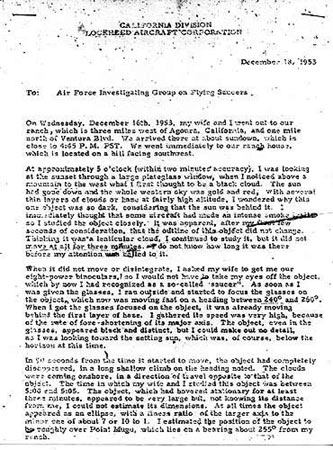 |
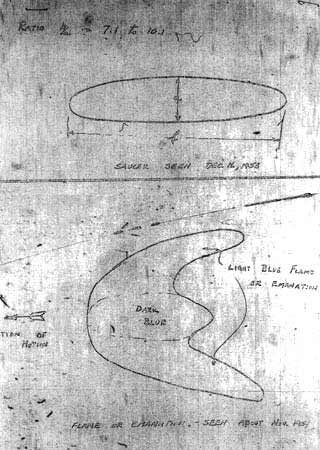 |
Irony
Johnson's formidable political and engineering skills overcame any negative effects the sighting may have had on his reputation, and even though the Air Force did reject his modified XF-104 reconnaissance aircraft concept, he was victorious in the end when, in late 1954, he was awarded a contract for a developed version of the CL-282 by the CIA. Code named AQUATONE, but known to Johnson's Skunk Works design group as the "Angel," the glider-like jet (later designated "U-2") would begin test flights at Nevada Test Site Area 51 in August 1955. Soon, according to the official CIA history of the AQUATONE program, the U-2’s gleaming sunlit surfaces would begin generating dozens of high-altitude UFO sightings, particularly among airline pilots on the Chicago-Los Angeles routes. The CIA's history asserts that the U-2 itself was thus responsible for "over half of all UFO reports" of the 1950s. [5]
 |
AQUATONE number 1 at Area 51, July 1955 |
Lear Electronics, a company owned by another aviation legend, William Lear Sr, built the crucial autopilot for the AQUATONE. By the 1980s, Lear's son John would be promoting stories concerning the existence of alien spacecraft being stored, or even flown, at Area 51. Some of the early versions of these tales claimed that these UFOs were being operated by Lockheed under the code name REDLIGHT.
See: REDLIGHT
And
in fact, in the 1970s, when the Skunk Works, under its new head, Ben Rich,
began studying methods of drastically reducing the radar cross-section
of aircraft, its engineers had toyed with saucer-shaped designs. Stymied
by the non-aerodynamic faceted surfaces dictated by the electrical engineers
who were responsible for finding ways to scatter radar waves from the
airplane's skin, some Skunk Works oldtimers pondered even more exotic
forms. "Several of our aerodynamics experts," Rich recalled,
including Dick Cantrell, seriously thought that maybe we would do better trying to build an actual flying saucer. The shape itself was the ultimate in low observability. The problem was finding ways to make a saucer fly. Unlike our plates, it would have to be rotated and spun. But how? The Martians wouldn't tell us.
But the irony becomes even richer, straining credibility. About the time of the December 1953 sighting by Johnson and his test pilots, Lockheed had won a contract from the Naval Research Laboratory to modify a WV-2 with a new, advanced AN/APS-82 radar that would enable air targets to be more easily detected in high sea-clutter states. The new antenna's size - 17.5 feet wide - was such that it was initially thought that it could not be accommodated on an aircraft (one concept was to place it in an airship) but Lockheed’s engineers, beginning their design work in January 1954, had devised a unique solution. Wind tunnel tests demonstrated that a properly-shaped rotating fairing could provide enough lift to nearly offset the weight of the antenna system. An 18,000 lb lenticular "rotodome" some thirty feet in diameter -- the first of its kind -- was installed on a WV-2 that was retained by Lockheed as an experimental model. It was the same aircraft, Constellation airframe number 4301, that had been involved in the December 1953 UFO sighting. The WV-2E made its first flight with the saucerlike fairing in August 1956.
 |
WV-2E 126521 in flight with rotodome |
 |
|
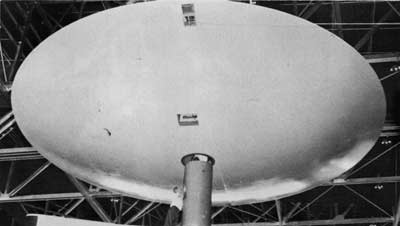 |
Rotodome being installed on aircraft pylon |
The shape of the rotodome (which had a strong resemblance to Price's supersonic saucer design), probably combined with company lore about the UFO incident on the WV-2 (and maybe Van Tassel and Angelucci too), proved too much for Lockheed's engineers, and just before the dome was installed on the aircraft, they decided to have a bit of fun by using it as a prop in a saucer spoof photo.
 |
The photo lacks clarity, but a small entity appears to be emerging from a hatch atop the dome. He waves to the eager Lockheed technicians...
 |
courtesy Renee Francillon |
Notes
[1] The Lockheed case came to my attention through a reference in Mike Hall's and Wendy Connors' book "Summer of the Saucers." Hall and Connors, in turn, had learned of it from one of veteran UFO historian Loren Gross's invaluable monographs. I was intrigued by the unusual sketch of the UFO that accompanied the report and was curious as to which Lockheed engineer was responsible. The Hall-Connors version of the story was drawn from the "sanitized" Blue Book files released to the public in the 1970s in which the identities of the witnesses had been obscured. Mike Hall kindly provided the Blue Book microfilm roll containing the file. Mary Castner of CUFOS gave indispensable assistance in this project, and Brad Sparks's encyclopedic knowledge of the CIA's interaction with UFOs, FOIA releases and general UFO history led to recovery of unsanitized versions of the Blue Book case file which contained vital information. This article would not exist without their outstanding cooperation.
[2]
Extensive declassified documentation on CIA's interaction with UFOs makes
it clear that Phil Strong was the Agency's point man on the issue as late
as 1962. While Pocock states that he considers it unlikely that Strong
was Johnson's source of information concerning the Air Force reconnaissance
project (and other Lockheed officials already knew of it), senior CIA
official Robert Amory recalled that this was the case. In any event, Johnson
clearly had close ties with Strong, who was moving in rather interesting
circles. Strong had links with strategic reconnaissance studies such as
the 1952 MIT/Lincoln Laboratory "Beacon Hill" project and the
reconnaissance panel of the USAF Scientific Advisory Board. At the same
time, he was involved with CIA's Office of Scientific Intelligence UFO
research. See http://www/foia.ucia.gov/
[3]
Wimmer and Ware would be crew members on early flights of another famous
Lockheed product, the C-130 Hercules, in 1954.
[4]
According to a former senior aerospace management official who knew Johnson,
USAF Chief of Staff General Hoyt Vandenberg had given a briefing to the
heads of the major aviation companies circa 1948 in which he emphasized
the Air Force’s continuing concern with UFOs and its ongoing investigation
of reports.
[5] To UFO researchers, who know of tens of thousands of sighting reports, this controversial claim seems absurd on its face, but it may be a matter of semantics and perspective. Former CIA photoanalyst Dino Brugioni states that he was one of the liaison points between the U-2 program and Air Force UFO investigators. Brugioni claimed that airline pilot reports that might have been stimulated by early U-2 development flights in the Nevada area circa 1955-6 were referred to him by certain AQUATONE-cleared Air Force personnel. He would check flight plans and inform the Air Force investigators of probable "hits." It appears that from CIA’s point of view, many UFO reports that it learned of via this highly selective channel were caused by the U-2.
Sources
-,
United States Air Force Biography, Lt General Donald Putt, http://www.af.mil/news/biographies/putt_dl.html
Beschloss,
Michael R, Mayday: Eisenhower, Khrushchev and the U-2 Affair. New
York: Harper & Row, 1986
Brugioni,
Dino, correspondence with author, April 1994
Clark,
Jerome, The UFO Encyclopedia, Volume 2 - entries for Angelucci,
Orfeo Matthew and Van Tassel, George W
Dwayne
A Day, John Logsdon, and Brian Latell, (eds.), Eye in the Sky: The
Story of the Corona Spy Satellites. Washington, DC: Smithsonian, 1998
Francillon,
Rene J, Lockheed Aircraft Since 1913. Annapolis, MD: Naval Institute
Press, 1987
- , Lockheed Constellation Military Variants. Wings of Fame, Vol 20
Ginter,
Steve, Naval Fighters Number Eight: Lockheed C-121 Constellation.
Simi Valley, CA: Naval Fighters, 1983
Gross,
Loren, UFOs: A History, 1953: August-December. Fremont, CA: 1990
Hall,
Michael David and Wendy Ann Connors, Captain Edward J Ruppelt: Summer
of the Saucers - 1952. Albuquerque: Rose Press, 2000
Haines,
Gerald K, "A Die-Hard Issue: CIA's Role in the Study of UFOs, 1947-1990."
Studies in Intelligence Vol 0, No 1, 1997 (http://www.cia.gov/csi/studies/97unclass/ufo.html)
Johnson,
Clarence L, Kelly: More Than My Share Of It All. Washington, DC:
Smithsonian Press, 1985
Jung,
Carl G, Flying Saucers: A Modern Myth of Things Seen in the Skies.
Princeton University Press, 1978
McIninch,
Thomas P, "The OXCART Story," Studies in Intelligence
15, 1 (Winter 1971)
Miller,
Jay, Lockheed's Skunk Works. Arlington, TX: Aerofax, 1993
- , Aerograph 3: Lockheed U-2. Austin, TX: Aerofax, 1983
Pace,
Steve, Lockheed Skunk Works. Osceola, WI: Motorbooks, 1992
Pearson,
June, "This is a Story About Mr Van Tassel Who Lives in a Rock and
Has a Time Machine." Desert Magazine, March, 1967
Pedlow,
Gregory W and Donald E Welzenbach, The Central Intelligence Agency
and Overhead Reconnaissance: The U-2 and OXCART Programs, 1954-1974.
Washington, DC: CIA, 1992
Peebles,
Curtis, Dark Eagles: A History of Top Secret US Aircraft Programs.
Novato, CA: Presidio, 1995
- , Shadow Flights: America's Secret Air War Against The Soviet Union. Novato, CA: Presidio, 2000
Pocock,
Chris, The U-2 Spyplane: Toward The Unknown. Atglen, PA: Schiffer,
2000
Polmar,
Norman, Spyplane: The U-2 History Declassified. Osceola, WI: MBI,
2001
Rich,
Ben and Leo Janos. Skunk Works. New York: Little, Brown and Company,
1994
Richelson,
Jeffrey T., The Wizards of Langley: Inside the CIA's Directorate of
Science and Technology. Boulder, CO: Westview Press, 2001
St
Peter, James, The History of Gas Turbine Engine Development in the
United States...A Tradition of Excellence. Atlanta, GA: International
Gas Turbine Institute of The Society of Mechanical Engineers, 1999
Sloop,
John L, Liquid Hydrogen as a Propulsion Fuel. Washington, DC: NASA,
1978
Sturm,
Thomas A, The USAF Scientific Advisory Board: Its First Twenty Years.
Washington, DC: Office of Air Force History, 1987
Wise,
David and Thomas B Ross, The U-2 Affair. New York: Bantam, 1962
Zuk, Bill, Canada's Flying Saucer: The Story of Avro Canada's Secret Projects. Erin, ON: Boston Mills Press, 2001